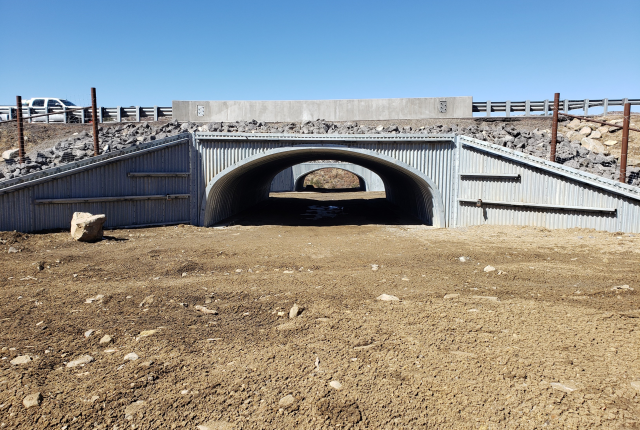IN JULY 2020, Squeaks left Santa Ana Pueblo. Fitted with a GPS tracking collar by the pueblo’s Department of Natural Resources, the subadult male mountain lion made an extraordinary 558-mile journey to Mesa Verde National Park in southwestern Colorado. Squeaks crossed the rugged mesa and canyon country of northwestern New Mexico, skirted towns, swam Navajo Lake—twice—and struggled to navigate a maze of highways. Eventually, in late September, Squeaks made his way under US 550 near Cuba and continued north.
The epic journey highlights a critical issue facing wildlife in New Mexico. Highways effectively work as deadly walls, impeding wildlife movement and decimating animal populations.
In New Mexico, more than 1,200 wildlife-automobile collisions are reported across the state each year, although the number is considered a serious undercount.
While firm wildlife-impact numbers are hard to come by, the New Mexico Department of Transportation (NMDOT) reported an average of 671 deer and 3,041 elk involved in crashes each year from 2002 to 2018.
“Roadkill is not only eliminating animals, it’s in many cases eliminating those healthy animals that populations need to remain strong,” writes Ben Goldfarb, author of Crossings: How Road Ecology Is Shaping the Future of our Planet. Similarly, he notes, highways act as a barrier that keep wildlife from accessing water, food, and habitat, shrinking the gene pool and making wildlife more susceptible to diseases or the impacts of climate change.
To address this, New Mexico is implementing a Wildlife Corridors Action Plan to guide NMDOT and the Department of Game & Fish to protect areas vital for wildlife movement and create fresh infrastructure that helps animals safely cross heavily trafficked highways.
For the Pueblo of Santa Ana, the issue goes beyond safety. “The relationship we’ve had with animals over eons is an intrinsic part of who we are,” says Governor Myron Armijo. “Without them, a piece of us is missing.”
In 2005, the pueblo adopted its own wildlife conservation code that allowed for data gathering—such as the travels of Squeaks—to help support regional wildlife populations. “I-25 is like a wall to many species,” says Glenn Harper, Santa Ana’s range and wildlife division manager. “Animals simply won’t cross. Those that try tend not to make it.”
Over the past decade, the state has built 10 wildlife crossings, including one in Tijeras Canyon east of Albuquerque and at Ratón Pass near the Colorado border. Legislators also allocated an additional $50 million for construction of new passages in early 2025. The Wildlife Corridors Action Plan pinpointed 30 collision hot spots across the state with 11 in need of urgent action, including stretches near Silver City, Ruidoso, Glorieta Pass, and in the Sacramento Mountains. Santa Ana Pueblo is working with the state to construct wildlife passages along 19 miles of I-25 and nearly eight miles of US 550.
The current top priority is a $45 million project on US 550, north of Cuba, to construct underpasses and overpasses with eight-foot-high fencing meant to both keep wildlife from highways and funnel them into the passages. That’s because different species have different needs when it comes to wildlife passages. Elk and pronghorn do not like underpasses, preferring a vegetated bridge over the highway. Deer, bear, mountain lions, coyotes, and bobcat are more comfortable with underpasses, provided they are at least 25 feet wide, 12 to 14 feet high, with a length less than 100 feet.
Done right, wildlife crossings are effective. In Canada’s Banff National Park, a single overpass reduced wildlife-vehicle collisions by 80 percent. An overpass in southern Arizona reduced elk collisions by 90 percent. Utah reports a 98.5 percent drop in deer mortality, thanks to two underpasses beneath I-15.
Under former President Joe Biden’s administration, tribal, state, and local governments were able to tap into a $350 million infrastructure fund for wildlife corridors, but that funding now appears under threat. “The future is clouded,” says Jim Hirsch, wildlife coordinator with NMDOT. “What we need is a permanent well-funded program, not just a pilot program.”
As humans and our infrastructure increasingly spread across the landscape, human-wildlife conflicts are bound to increase. Tragically, after several years navigating the maze of roads and highways throughout the Four Corners region, Squeaks ended up in trouble. After snatching a domesticated goat west of Mesa Verde, the six-year-old lion was euthanized. “It’s certainly not the end we had hoped for,” Harper says. “But at least Squeaks was able to spread his genes across the region, and that is what connectivity is all about.”




